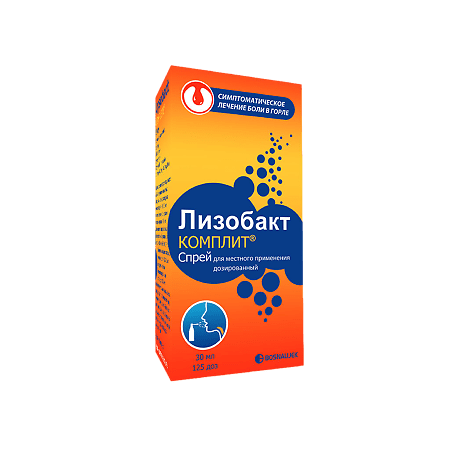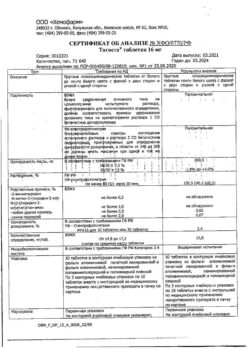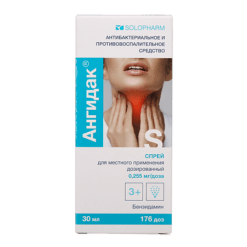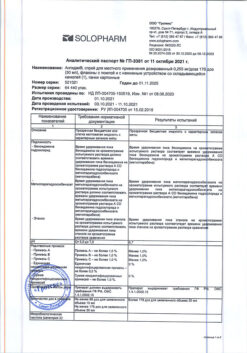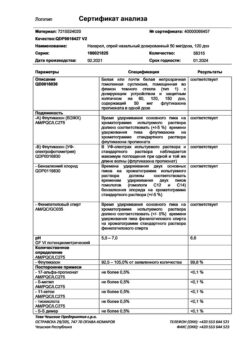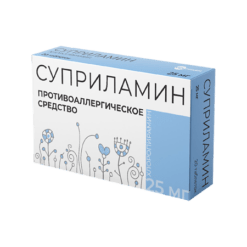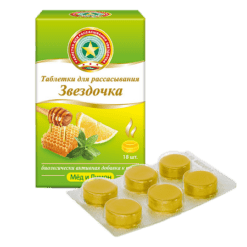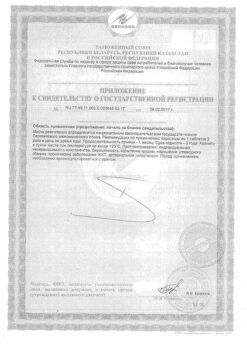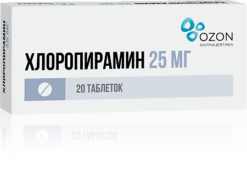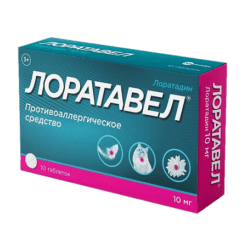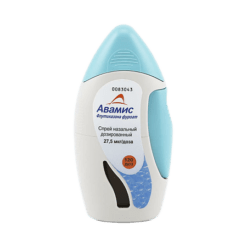No products in the cart.
Lisobact COMPLETE, spray 0.1 mg+4, 0.0 mg+0.3 mg/dose 125 doses
€11.43 €10.00
Description
Pharmacotherapeutic group: antiseptic.
ATX code: R02AA.
Pharmacological properties
Pharmacodynamics
A combination drug whose action is due to its constituent components.
Lidocaine hydrochloride
Lidocaine hydrochloride is an amide-type local anesthetic with a superficial analgesic effect. Lidocaine blocks the generation and conduction of nerve impulses in the sensitive, motor and autonomic nerve fibers. At the molecular level, lidocaine affects mainly the cell membrane: it specifically blocks the sodium ion channels in the inactive state, which prevents the generation of the action potential, preventing the nerve impulse conduction when lidocaine is applied locally near the nerve. In general, local anesthetics block autonomic nerves, small unmyelinated (sensation of pain) and small myelinated (sensation of pain, temperature) faster than large myelinated fibers (sensation of touch, pressure).
It is effective in all types of local pain relief. It dilates the blood vessels. Does not have an irritating effect on the tissue.
Lysocym hydrochloride
Lysocym hydrochloride is a mucopolysaccharide that destroys (lyses) the cell walls of bacteria by hydrolyzing its peptidoglycans (in particular, murein). It is active against Gram-positive and some Gram-negative bacteria, viruses and fungi.
Cetylpyridinium chloride
Cetylpyridinium chloride is an antiseptic of the group of quaternary ammonium bases, has variable antifungal activity, bactericidal action against Gram-positive and Gram-negative bacteria, effective against some viruses. Cetylpyridinium chloride has a disinfectant effect on mucous membranes.
Pharmacokinetics
Lysobact COMPLETE® is used topically and has an effect on the oropharyngeal area. If swallowed, a small amount of the drug may enter the digestive system.
Lidocaine hydrochloride
Lidocaine is quickly absorbed through the oral mucosa, the digestive tract or through damaged skin. About 65% of lidocaine binds to plasma proteins. After absorption, lidocaine is rapidly distributed to all tissues of the body, penetrates through the placental and blood-brain barrier, and is excreted into breast milk.
Lidocaine is extensively metabolized in the liver, its bioavailability after oral administration is 35%. About 90% of the administered dose is dealkylated to form monoethylglycinkylidide (MEGX) and glycinkylidide (GX), which provide therapeutic and toxic effects of lidocaine. GX has a longer half-life than lidocaine (about 10 h) and can cumulate with repeated administration. Subsequently, additional biotransformation occurs, and metabolites are excreted by the kidneys, including about 10% in the form of unchanged lidocaine.
Inhibition of cytochrome P450 isoenzymes CYP1A2 and CYP3A4 may increase lidocaine concentrations.
The elimination half-life of lidocaine from plasma is approximately 1.6 hours.
Special patient groups
Due to rapid metabolism, the pharmacokinetics of lidocaine may be affected by conditions that impair hepatic function. In patients with impaired liver function the half-life of lidocaine may be increased by a factor of 2 or more.
Disordered renal function does not affect the pharmacokinetics of lidocaine, but may lead to cumulation of its metabolites.
Lisocime hydrochloride
Lisocime hydrochloride is practically not absorbed through the oral mucosa.
Cetylpyridinium chloride
Cetylpyridinium chloride is poorly absorbed through the oral mucosa.
Indications
Indications
Symptomatic treatment of sore throat in infectious and inflammatory diseases of the pharynx and larynx (acute and chronic pharyngitis, pharyngolaryngitis, tonsillitis) in adult patients as part of complex therapy.
Pharmacological effect
Pharmacological effect
A combined drug whose effect is determined by its constituent components.
Lidocaine hydrochloride
Lidocaine hydrochloride is an amide-type local anesthetic that has a superficial analgesic effect. Lidocaine blocks the generation and conduction of nerve impulses in sensory, motor and autonomic nerve fibers. At the molecular level, lidocaine acts primarily on the cell membrane: it specifically blocks sodium ion channels in an inactive state, which prevents the generation of an action potential, preventing the conduction of a nerve impulse when lidocaine is applied topically near a nerve. In general, local anesthetics block autonomic nerves, small unmyelinated nerves (sensation of pain) and small myelinated nerves (sensation of pain, temperature) more quickly than large myelinated fibers (sensation of touch, pressure).
Effective for all types of local anesthesia. Dilates blood vessels. Does not irritate fabrics.
Lysozyme hydrochloride
Lysozyme hydrochloride is a mucopolysaccharide that destroys (lyses) bacterial cell walls by hydrolyzing its peptidoglycans (in particular, murein). Active against gram-positive and some gram-negative bacteria, viruses and fungi.
Cetylpyridinium chloride
Cetylpyridinium chloride is an antiseptic from the group of quaternary ammonium bases, has variable antifungal activity, a bactericidal effect against gram-positive and gram-negative bacteria, and is effective against some viruses. Cetylpyridinium chloride has a disinfectant effect on the mucous membrane.
Special instructions
Special instructions
Lidocaine hydrochloride
Lidocaine has porphyrogenic potential, and in patients with acute porphyria it should only be used for emergency, life-threatening indications. Porphyria precautions should be observed in all patients.
When applying the drug to the mucous membrane in high doses or during long-term treatment, the risk of developing a systemic effect of local anesthetics increases (disorders of the central nervous system with the development of seizures, depression of the cardiovascular system).
The drug should be used with caution in patients with epilepsy, cardiac conduction disorders, liver dysfunction, and a history of allergic reactions.
The use of the drug is contraindicated in patients with hypersensitivity to other amide-type local anesthetics (such as bupivacaine, levobupivacaine, mepivacaine, prilocaine, ropivacaine).
Lysozyme hydrochloride
Lizobact COMPLETE® should not be used in patients with a history of allergic reactions.
Cases of allergic reactions (hypersensitivity) have been reported in connection with the use of lysozyme. Therefore, the patient should stop using this medicine and consult a doctor if rash, itching or redness of the skin, swelling of the face, lips, tongue or throat, breathing and/or difficulty swallowing occurs, as these may be signs of an allergic reaction to Lysobact COMPLETE®.
Cetylpyridinium chloride
With long-term use, local irritation may potentially occur due to the cetylpyridinium chloride contained in the drug.
Lizobact COMPLETE® should not be taken with milk, as it reduces the antimicrobial activity of cetylpyridinium chloride.
The drug is not recommended for use in the presence of open wounds in the oral cavity, because Cetylpyridinium hydrochloride slows down wound healing.
Long-term use of cetylpyridinium hydrochloride can lead to disruption of the normal microflora of the oral cavity with the risk of developing a bacterial or fungal infection.
The drug is not intended for long-term, repeated or continuous use. If symptoms persist for more than 5 days and/or if other symptoms appear (severe pain in the oropharynx, nausea, vomiting), or a concomitant rise in temperature, you should consult your doctor.
If patients have difficulty swallowing, they should not use this drug; they should see a doctor.
When local anesthetics are used in the oral cavity and oropharynx, the local anesthetic effect may lead to impaired swallowing, potentially increasing the risk of aspiration. In this regard, patients should be warned not to eat and/or drink for one hour after applying Lysobact COMPLETE®. In addition, it is recommended to avoid brushing teeth and chewing gum during the period while the effect of anesthesia in the oral cavity and/or oropharynx remains.
Care should be taken not to allow the solution to come into contact with the eyes. If this happens accidentally, rinse your eyes with clean water or eye wash and keep your eyes open for at least 15 minutes.
Lizobact COMPLETE® does not contain sugar and is suitable for use in people with diabetes.
Impact on the ability to drive vehicles and machinery
The drug Lizobact COMPLETE® does not affect the ability to drive vehicles and operate machinery
Active ingredient
Active ingredient
Lidocaine, Lysozyme, Cetylpyridinium chloride
Composition
Composition
Active ingredients: Lidocaine hydrochloride monohydrate – 0.1066 mg (in terms of lidocaine hydrochloride – 0.10 mg); Lysozyme hydrochloride – 4.00 mg (in terms of anhydrous substance – 160,000 FIP UNITS *); Cetylpyridinium chloride monohydrate – 0.315 mg (in terms of cetylpyridinium chloride – 0.30 mg)
Excipients: Glycerol – 40.00 mg; Propylene glycol – 4.00 mg; Methyl parahydroxybenzoate – 0.096 mg; Propyl parahydroxybenzoate – 0.024 mg; Peppermint flavor – 0.02 mg; Sodium hydroxide – q.s.; Purified water – up to 0.20 ml.
* – 1.0 mg of lysozyme hydrochloride corresponds to 40,000 FIP UNITS.
Pregnancy
Pregnancy
Use during pregnancy and breastfeeding is contraindicated.
Contraindications
Contraindications
Hypersensitivity to lidocaine hydrochloride and other amide-type local anesthetics, lysozyme hydrochloride, cetylpyridinium chloride, as well as to any of the components of the drug.
Hypersensitivity to chicken egg white.
Open wounds of the oral cavity.
Children under 18 years of age (efficacy and safety have not been studied).
Pregnancy and breastfeeding.
Side Effects
Side Effects
Lizobact COMPLETE® may cause headaches, stomach problems and diarrhea due to the presence of glycerol.
The drug Lizobact COMPLETE® can cause symptoms similar to alcohol due to the presence of propylene glycol in the composition.
The drug Lizobact COMPLETE® may cause delayed allergic reactions (for example, contact dermatitis) or (less commonly) immediate reactions (urticaria, bronchospasm) due to the presence of methyl and propyl parahydroxybenzoate in the composition.
Interaction
Interaction
Lidocaine hydrochloride
Despite the potential for numerous interactions between lidocaine and other drugs, in this case, most likely, they will not have clinical significance due to the fact that Lizobact Complit® is applied topically.
Concomitant use of Lizobact Complit® with other drugs that limit hepatic blood flow (for example, propranolol, cimetidine) may lead to a decrease in the clearance of lidocaine. With long-term use in combination with other drugs that induce microsomal enzymes (for example, phenytoin, barbiturates), due to which the drug is metabolized, an increase in the dose of lidocaine may be required. Inhibition of cytochrome P450 isoenzymes CYP1A2 (fluvoxamine) and CYP3A4 (itraconazole, erythromycin) may increase lidocaine concentrations.
The inhibitory effect of lidocaine on the heart is additive to the effects of beta-blockers and other antiarrhythmic drugs. Cardiac glycosides weaken the cardiotonic effect, curare-like drugs enhance muscle relaxation. Procainamide increases the risk of developing central nervous system excitation and hallucinations. When prescribed with antiarrhythmic drugs (amiodarone), the negative inotropic effect may be enhanced.
Hypokalemia caused by acetazolamide, loop diuretics and thiazides may counteract the effect of lidocaine.
With the simultaneous administration of lidocaine and hypnotics or sedatives, their inhibitory effect on the central nervous system may be enhanced.
With intravenous administration of sodium thiopental against the background of lidocaine, respiratory depression is possible.
Under the influence of MAO inhibitors (furazolidone, procarbazine, selegiline), the local anesthetic effect of lidocaine may be enhanced. Patients taking MAO inhibitors should not be given parenteral lidocaine.
With the simultaneous use of lidocaine and polymyxin, an increased inhibitory effect on neuromuscular transmission is possible, so in this case it is necessary to monitor the patient’s respiratory function.
Lysozyme hydrochloride
Lysozyme hydrochloride enhances the effect of antibiotics, incl. penicillin, chloramphenicol, nitrofurantoin, diuretics, weakens the activity of levodopa.
Cetylpyridinium chloride
The drug should not be taken simultaneously with milk, since the antimicrobial activity of cetylpyridinium chloride is reduced.
While using Lizobakt Complit®, patients should not simultaneously use other local anesthetics to disinfect the oral cavity and/or pharynx.
If the patient uses the above or other medications (including over-the-counter medications), you should consult your doctor before using Lizobakt Complit®.
Overdose
Overdose
Symptoms
Application of local anesthetics to the oral mucosa may lead to difficulty swallowing, thereby increasing the risk of aspiration into the respiratory tract. Therefore, an overdose of Lizobact Complit® may lead to a slight increase in the risk of excessive local anesthetic effect in the glottis, which can subsequently lead to weakening of the control of the swallowing reflex.
Lidocaine hydrochloride. Very high concentrations of lidocaine in the blood can provoke effects on the central nervous system and/or the cardiovascular system. Initial CNS manifestations may include nervousness, dizziness, tinnitus, nystagmus, psychomotor agitation, restlessness, paresthesia, blurred vision, nausea, vomiting, and tremor, which may progress to spinal cord depression and tonic and clonic seizures. Reactions from the cardiovascular system are characterized by its depression and are manifested by arterial hypotension, myocardial depression, bradycardia and the potential risk of cardiac arrest.
Although the bioavailability of lidocaine is low, it may be sufficient to cause significant toxicity if the drug is ingested. CNS toxicity, seizures, and death have been reported following ingestion of topical medications. However, in the case of Lysobakt Complit®, more than 1 liter of spray must be swallowed in order for the amount of lidocaine (0.5 g or more) to be sufficient to produce a clinically significant toxic effect.
Lysozyme hydrochloride. No cases of overdose have been observed.
Cetylpyridinium chloride. Signs and symptoms of intoxication when ingesting significant quantities of cetylpyridinium chloride: nausea, vomiting, edema, cyanosis, asphyxia with subsequent paralysis of the respiratory muscles, central nervous system depression, arterial hypotension and coma.
Treatment
Treatment of lidocaine overdose includes ensuring adequate ventilation and stopping epileptic seizures. Mechanical ventilation with oxygen through assisted breathing or controlled breathing is given as needed. Sodium thiopental and diazepam can be used to eliminate epileptic seizures. If ventricular fibrillation or cardiac arrest occurs, adequate cardiovascular resuscitation is necessary. Several doses of epinephrine and sodium bicarbonate should be administered as soon as possible.
In case of overdose, the patient should stop using the drug and consult a doctor.
Storage conditions
Storage conditions
At a temperature not exceeding 25 °C. Do not freeze. Keep out of the reach of children!
Shelf life
Shelf life
3 years. Do not use after the expiration date stated on the package.
Manufacturer
Manufacturer
Bosnalek JSC, Bosnia and Herzegovina
Additional information
| Shelf life | 3 years. Do not use after the expiration date stated on the package. |
|---|---|
| Conditions of storage | At a temperature not exceeding 25 ° C. Do not freeze. Keep out of reach of children! |
| Manufacturer | Bosnalek AS, Bosnia and Herzegovina |
| Medication form | dosed topical spray |
| Brand | Bosnalek AS |
Related products
Buy Lisobact COMPLETE, spray 0.1 mg+4, 0.0 mg+0.3 mg/dose 125 doses with delivery to USA, UK, Europe and over 120 other countries.

